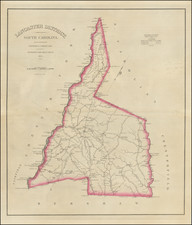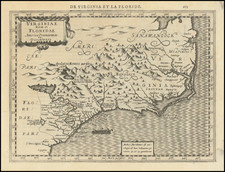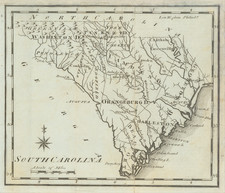Final State of One of the Most Important Early Maps of the Carolinas
Final state of the Thornton, Morden & Lea map of the Carolinas, one of the most important maps of the period.
The map is a foundational maps of the Carolinas, influencing the mapping of the region for the final decades of the 17th Century and well into the 18th Century. As noted by Jay Lester, the map is
one of the rarest and most important seventeenth century printed maps of Carolina. The map was published in 1685 by the short-lived partnership between three leading map sellers of the period: John Thornton, Robert Morden, and Phillip Lea. Their base map was the now unobtainable second Lords Proprietors’ map of Carolina by Gascoyne, published in 1682. The Thornton-Morden-Lea map derives from both the first and second states of the Gascoyne map. However, it is not simply a modified Gascoyne map; Thornton et al also incorporated data from other sources. Though not copied verbatim, the soundings along the Outer Banks were unequivocally derived from an untitled manuscript map in the Blathwayt Atlas (John Carter Brown Library). For the interior, Thornton et al chose to improve upon the Gascoyne map rather than revert to the Lederer-inspired geography of the Ogilby-Moxon and so-called Speed maps of Carolina from the previous decade. As such, the depiction of the river system is, without question, the most accurate to date.
The interior is decorated with two well-antlered deer or elk, two panthers, turkey, boar, raccoon, and… an ostrich?! Cumming described the 1682 Gascoyne map as “the most accurate representation of the Carolina region yet to appear.” Yet, in just a few short years, it was surpassed by Thornton, Morden, & Lea’s A New Map of Carolina. Decades would pass before Carolina cartography would see further noticeable improvement.
The map is also the first map of the Carolinas to provide meaningful details on early settlements, including a list of 33 early settlements in the Carolina Colony. The map was also the first map of the Carolinas to influence other European mapmakers. Within a decade, Pierre Mortier would create a French copy, which he included in his Neptune Francois.
States
State 1: circa 1685, with imprint of Thornton, Morden, and Lea in the title cartouche.
State 2: circa 1695, imprint altered to By/ Philip Lea at the Atlas and Hercules/ in Cheap Side/LONDON. The inset of Charleston Harbor has been enlarged and now has title at top: ASHLEY & COOPER RIVER.
State 3: circa 1715, imprint altered to Sold by Geo: Willdey at the Great Toy,/ Spectacle, Chinaware and Print Shop,/ ye Corner of Ludgate Street near St Pauls/ LONDON.
Rarity
The map is of the utmost rarity, especially the final state by George Willdey.
The last example of the map to appear at auction was in the Streeter Sale in 1967, acquired by Streert from the Huntington Library (Lot 1112, sold for $600). The last example offered in a dealer catalog was in 2009 (Arkway Catalog 69, Item 9 -- $48,000, acquired from Ashley Baynton Williams in 2008), which now resides in a private collection in North Carolina.
The final state of the map is apparently the rarest. Burden located only the examples at the John Carter Brown Library (lacking the bottom left corner) and the Library of Congress. We note also a heavily damaged example in the State Archives of North Carolina. We were unable to locate any other example at auction or in dealer catalogs.
George Willdey was an optical instrument maker. He also sold globes, maps, and toys at his shop in Ludgate Street. Born in Staffordshire, Willdey moved to London after the death of his father, where he was bound as an apprentice to John Yarwell, an optician. He was made free of the Spectaclemakers’ Company in 1702, when he began work as a journeyman.
A few years later, Willdey started in business with Timothy Brandreth, working under the sign of the Archimedes and Globe. They competed for business with Yarwell and other opticians, advertising their wares in trade cards and periodical advertisements.
Willdey and his wife, Judith, had five children, three of which survived to adulthood. Judith was a Huguenot, which allowed Willdey to create a wider network of artisans and craftsman. He expanded his stock to toys and household decorations, in addition to instruments. From 1709 he also sold printed goods, including maps and globes, which he sold in partnership with John Senex. Willdey purchased the copper plates for many maps, such as Christopher Saxton’s atlas of England and Wales.
We note the following addresses:
- From 1707 to 1713 he operated "At the Archemedes & Globe, Ludgate Street." sometimes described as "Archimedes and Globe next the Dog Tavern nearer Ludgate."
- In 1712 in partnership with Timothy Brandreth also advertised at Archimedes and Globe over against the Royal Exchange in Cornhill.
- In 1715 his location was described as "At the Great Toy and Print Shop, the corner of Ludgate Street, next to St. Paul's"
- 1718 to 1737 as "At the Great Toy, Spectacle, China-Ware, and Print Shop, the Corner of Ludgate Street near St. Pauls London."
In 1717, Willdey split with Brandreth and expanded his stock further to include coffee and tea, snuff, medicine, china, and cutlery. He sold these wares from his shop at Ludgate and St. Paul’s Churchyard. He aggressively advertised his business in hundreds of newspaper advertisements; he also adopted many advertising gimmicks, such as erecting a giant burning glass on the roof of his store. Willdey was a leader in the Spectaclemakers’ Company. His wife frequently helped with the business and eight of his fifteen apprentices were women, which was very unusual for either the instrument and toy trades at the time.
Willdey died in 1737, although he had been in declining health for years and had tried to pass the business to his son, Thomas. He was remembered in The Old Whig, or, the Consistent Protestant as the “most noted Toyman in Europe.” After his death, the shop was run by Judith along with a former apprentice, Susanna Passavant. Thomas, it seems, was not suited to business.
Willdey’s daughter, Jane Frances, married a Peter Fenoulhet, clerk of the entries in the Excise Office. Fenoulhet sued on behalf of their son over the mismanagement of the family business by Thomas. These lawsuits produced eleven inventories of household and commercial stock between 1730 and 1737, the only extant shop accounts from the London instrument trade from this period.











![[ Extensively Annotated By An Early Owner ] Georgia from the latest Authorities](https://storage.googleapis.com/raremaps/img/small/100877.jpg)


![[Untitled Coast chart of North Carolina, South Carolina, Georgia, and Florida, with insets of the harbor of Charleston, S.C. and the entrance of the Saint Johns River]](https://storage.googleapis.com/raremaps/img/small/91737.jpg)